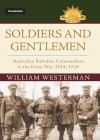Book Review - Soldiers and Gentlemen: Australian Battalion Commanders in the Great War 1914-1918
Soldiers and Gentlemen: Australian Battalion Commanders in the Great War 1914-1918
Written by: Dr William Westerman
Cambridge University Press, 2017,
ISBN 9781107190627, 320pp
Reviewed by: Colonel Michael Mumford
The Australian Army History series continues to produce excellent histories of the Australian Army and the latest, William Westerman’s Soldiers and Gentlemen, is devoted to the role of the battalion commander in the First World War. This book is the first examination of the background, role, and conduct of the Australian commanding officers (CO) during the Great War. Most unit and war histories include the actions taken by various COs, since the battalion was the chief means of identity in the 1st AIF (and has been ever since). However, this is the first time, for that War, that this level of command is the focus of study.
The book is not a rollicking account of daredevils leading men against terrible odds. In fact Westerman notes that the lead from the front mentality cost many COs their lives early in the War and was the result of an absence of good training, tactics and administration. Rather, the study is a rigorous analysis focussed on the three main roles of battalion commanders in that war: tactics (and training), unit administration, and leadership.
Despite the fact that the events are one hundred years old, commanders today will identify strongly with the experiences of the COs in the 1st AIF. It is obvious that the roles of COs now and then are very similar: to train the unit for specific operations, to conduct broad tactical planning using combined arms, and maintain unit cohesion in difficult and trying operational circumstances, all the while having little direct ability to influence tactical outcomes personally. Also, the paradox between lack of personal control over tactical outcomes, on the one hand, and the personal responsibility felt for those lost and injured, transcends the ages.
Westerman, rightly, does not try to show the Australian experience as unique to other Commonwealth armies except in the way in which Australian soldiers were disciplined, since the death penalty was off the table for theAustralians as a means of coercion. The description of the delicate balancing act for Australian COs, who needed to maintain discipline while shepherding a group of volunteers through extreme conditions, is well done. Westerman also does not sugar-coat the reality of the Australian soldiers’ discipline: at one point the desertion rate of Australians was four times that of any other nation, and yet despite this, the soldiers were often cited for their valour. A prime example is the 1st Battalion, late in the war, which suffered the ignominy of having half the battalion desert before an attack; only to win praise when the remaining half captured all their objectives and took fifty one enemy prisoners.
Westerman also does an excellent job explaining the very different infantry command experiences: Gallipoli, the horror of the stalemate on the Western Front in 1916-1917, and the war of limited manoeuvre in 1918. Westerman cleverly examines the performance and roles of unit commanders in each of these phases, an example being his analysis of the ages of the COs: from Gallipoli, where the average age was forty eight, to the Battle of Amiens in 1918 when the average age was only thirty three (the youngest of any Commonwealth army). In a society where we find it abhorrent to discriminate for reasons of age, the reality of the effect of the harsh conditions on the health of older battalion commanders, when compared to their younger counterparts, is challenging reading.
Apart from its high academic value, I would recommend this book to practitioners for two important reasons. First, it will sharply focus those who aspire to command, on to their most crucial responsibilities: tactical training, internal administration and logistics, and maintenance of morale.
This book is a cautionary tale for commanders who believe those roles can be effectively delegated to others. Second, it proves that nothing completely prepares a person for military operations and that flexibility in approach, adaptability of mind, and personal physical endurance are key attributes for success in unit command. Army Reserve members will also find particular interest in the pages of this history, since most of the COs were not ‘professional’ soldiers and volunteered from the Citizen Military Forces. Soldiers and Gentlemen is a welcome and hearty addition to the scholarly history of the Australian Army.



